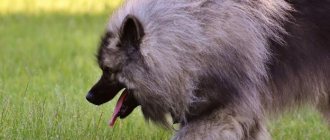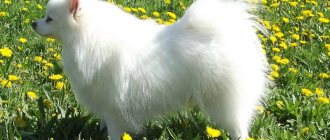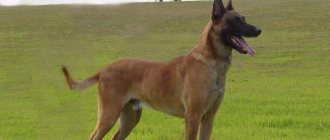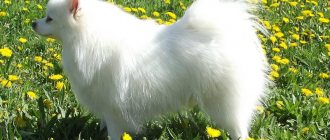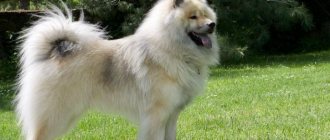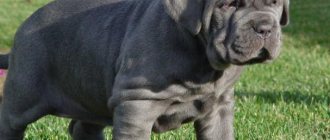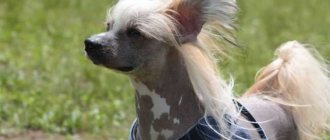German Spitz breed standard
Breed standard: German Spitz has FCI standard No. 97, which was adopted on January 25, 2013. Publication date of the previous standard: March 5, 1998.
Breed classification: Group 5. Spitz and primitive dogs. Section 4. European Spitz. No operational tests.
Features of the breed: when describing the German Spitz breed, it should be noted that all its varieties are very similar in appearance. So, these dogs have a medium-sized head, wide at the back and tapering towards the nose. The muzzle is proportional to the skull. The nose is small, round, black.
Dogs with brown fur have brown fur. The eyes are round or slightly oblong, medium in size, slightly oblique, dark.
The eyelids are black or dark brown, depending on the color of the animal. The ears are erect, high-set, pointed, and always in an upright position. The jaws are quite developed and have a scissor bite. The neck is wide, without dewlap, with a convex nape.
The tail is bushy, mobile, lies tightly on the back, sometimes with a double loop at the end. The croup is short and wide.
The chest is deep, its anterior part is well developed. The stomach is tucked. Limbs with strong bones, strong, muscular. The paws are round, miniature, with dense pads.
Coat color, height and weight of the German Spitz
The coat of the German Spitz is double, long, straight, with a short, dense undercoat, thick on the body and the back of the forelimbs. On the head, ears, front side of the limbs it is short and dense. The colors of the German Spitz can be different; each variety has its own shade of coat.
The Large German Spitz or Wolfspitz or Keeshond has a zoned gray color.
Height at withers: 43 – 55 cm.
Weight: 25 – 30 kg.
The average Spitz or Middle Spitz can be white, black, brown, orange, zonal gray. Other coat colors are also allowed.
Height at withers: 30 – 39 cm.
Weight: 11 kg.
Small or Kleinspitz height no higher than 29 cm. Weight: 8 – 10 kg. It has the same shades of coat as the Mittelspitz.
Miniature or Pomeranian, or Toy Spitz, or Miniature Spitz with a height of 18 - 22 cm. The shades of the coat are the same as those of other representatives of the breed.
When choosing a black German Spitz, you should know that its coat should be a uniform color, without any other shades. If there are beige spots on the paws or other parts of the body, then it is not a black Spitz, but a black and tan Spitz.
What the owner needs to consider
Inspecting the litter, you can see that puppies can have completely different sizes. Pay attention to the dog's initial weight or height because this will affect further development.
Once you purchase a puppy, consult your veterinarian. He will advise you on how to feed your baby correctly, how to exercise, and what vitamin complexes to use during the period of active growth. Puppies that are developmentally delayed may have musculoskeletal problems. Therefore, during walks it is necessary to ensure that the dogs do not receive excessive stress.
If a dog is overweight, but eats properly, then the reason is probably heredity. Alas, even the most qualified veterinarian is unable to combat this. The owner will have to come to terms with the fact that his pet will not be able to take part in exhibitions.
Pomeranian Spitz breed exhibitions (zoo portal)
Black and white German Spitz, photo of puppies
During puppyhood, coat color tends to change. A puppy that is black at birth may change color after 2 months. If during the change from puppy fur to adult fur. The nose, eyelids and lips remain black, which means her color will not change. In a large Spitz, only in the 3rd year of life does it acquire a permanent shade.
The white German Spitz dog (photo above) is the most expensive among other varieties of the breed, since it is quite difficult to breed. For example, when crossing two white Pomeranians, there is a risk of getting a larger dog than prescribed in the standard. Therefore, we have to gradually combine them with other colors, including orange, which gives a weak creamy tint, which in turn must be gradually removed. The result should be a pure white shade of wool without impurities or foreign shades.
It is worth noting that cream German Spitz puppies are born white, as evidenced by the following photo:
You cannot expect them to remain white as they mature, as their color will most likely change. Usually the color change occurs within 8 to 12 weeks. You can determine whether the coat color is white by looking at the color behind the ears. If in this zone it is cream or yellowish, then the dog will not be white, but will most likely turn orange, brown or light yellow.
Deviation from the norm
Regardless of the subspecies, maturation occurs the same for all Spitz-types. The journey from a furball to an adult dog takes 3 years.
Deviations in the speed of development relative to exhibition standards are due only to size and weight, which are genetically determined.
Small weight and size
Insufficient weight gain may mean a lack of vitamins and active elements in your pet’s diet. This is also affected by the miniature bitch and male who participated in the mating. There are no obvious diseases that can affect the development of the pet.
Exceeding the norm
Exceeding standards for a puppy does not play a big role. The growth rate may be greater than indicated in the table. This is due to natural feeding and activity of the animal.
Excessive weight in a puppy is not a deviation
But if, as an adult, a Spitz weighs more than it should, this may be a genetic feature. If the parents were still within the standards, contact your veterinarian. It may be necessary to review the diet and put your pet on a diet.
What the owner needs to consider
Please note that there may be puppies of different sizes in the same litter. It is the initial mass that determines what an adult dog will look like.
If the baby grows slower than normal, there may be problems with bones and joints. Don't let him jump from heights. Purchase a complex of vitamins for growth, after consulting with your veterinarian.
If the pet exceeds the standards, but does not overeat, and is not obese, genetics is most likely to blame. There is only one way out - to come to terms with the fact that he will not be able to participate in exhibition events.
Source
Character of the German (Pomeranian) Spitz and photos of dogs
By nature, German Spitz are friendly, affable, affectionate, and devoted to their owner. There is no anger, aggression, or importunity in them. They are slightly wary of strangers, but are not afraid of strangers. These animals, despite their compact size, become excellent watchmen and guardians of household property.
This photo clearly shows the external features of the small German Spitz.
As a rule, dogs of the German Spitz breed are family favorites, which is due to many positive traits in their character. These animals are affectionate, sociable, friendly, cheerful, active, determined and very brave. They become wonderful friends and companions for all household members, to whom they quickly get used to and become attached. In addition, dogs easily adapt to new living conditions and easily adapt to the rhythm of life of their owners. With older owners they behave quietly and calmly, with young owners they are more active. They love to get the attention of others and try to attract it to themselves in all possible ways: loud barking, jumping and running around family members. However, such pets will never get bored and if they feel that there is no need for their presence, they will go into their own corner.
By nature, the German Spitz dog is self-sufficient, intelligent and loyal. The animal is easy to train, quickly remembers even complex commands, and strives to conquer new heights.
The favorite activities of representatives of this breed are long walks in the fresh air (without a leash), running, games, and swimming. That is why they are ideal for people with an active lifestyle, who love to travel, relax outside the city, etc.
Psychology
All Pomeranians are friendly, intelligent, intelligent and make excellent companion dogs.
The largest, the Keeshond and the Great Spitz, like the Schipperke , are vigilant and capable of protecting the owner.
Medium and small are cheerful dogs, like miniature pinschers and Norfolk terriers , who love to run and play. They love water and swim willingly, and enjoy frolicking in nature.
The puppy should be raised affectionately, but firmly - these are pack dogs, they need a smart leader.
Small pets should be weaned from loud barking for no reason and excessive bullying towards large dogs.
The medium and small Spitz are cheerful dogs that love to run and play. They love water and willingly swim, and enjoy frolicking in nature.
Behavior of German dwarf (miniature) Spitz and their photos
Although the German Spitz (see photo above) is a breed of small dog, it has excellent hearing and watchdog qualities. Sensing danger, he begins to bark loudly and loudly. Compact size helps the animal move quickly and smoothly. Those who carefully observe the dog while walking will certainly get the impression that it is not running, but as if it is hovering above the ground.
If there are small children living in the house, the dog becomes a nanny for them, looking after them. The behavior of German dwarf (miniature) Spitz is characterized by patience and balance, so if a child hurts the dog in play, the Spitz will not bite or growl at him. This should not be used under any circumstances; on the contrary, care must be taken to ensure that children do not harm the animal.
Good-natured pets have a delicate, vulnerable psyche and remember the attitude towards themselves, which should be taken into account and raised with patience, affection, perseverance, but under no circumstances should they be rude or aggressive towards puppies, and later towards an adult dog.
It is also interesting that, thanks to its intelligence, speed and agility, the German Spitz dog breed has long been performing in circus performances, performing tricks and various funny acts.
When describing the German Spitz, it is worth noting that such a pet will be playful and active almost until old age. At a very mature age, he becomes slower and calmer, increasingly striving for solitude. It is more difficult for him to climb stairs, get up from a lying position, or perform any trick, even the simplest one. The dog's character also undergoes some changes over time. An old pet is more anxious, it is more difficult to tolerate separation from its owner, when left alone, it begins to howl, whine or bark. With a lack of attention, he withdraws into himself.
Attitude of the German Mini Spitz towards strangers
The German Mini Spitz shows distrust and wariness towards strangers. When meeting strangers, he often focuses on the behavior of the owner. He is brave, decisive and self-confident, thanks to which his guarding abilities are in no way inferior to large and strong dogs. Sometimes on walks, fighting Spitz dogs get into fights with large guard breeds.
So, this dog is suitable for people of any age, character and lifestyle. She gets along well with other pets and does not require large expenses for her maintenance, but she will need to be given a lot of time and attention.
You can find out more interesting information about the habits and character of the German Spitz by watching this video:
How to train correctly
The Spitz is easy to train, so you can easily raise a cultured and docile animal on your own. You just need to follow a few rules:
- Play with puppies carefully, do not pull limbs, do not cause pain.
- Keep it on a leash, as in a fit of curiosity the pet can jump out onto the roadway.
- When training, use only the “carrot” method: encourage, praise, give treats.
History of the German Spitz breed (small, medium and large)
As mentioned in the article, the German Pomeranian (see photo above) is a fairly old breed, existing for more than 2,500 years. This is evidenced by images of dogs on tablets and ancient dishes. Previously, only ordinary people kept such pets, since they guarded no worse than large dogs, and ate much less than them. Of course, maintaining them was very profitable. In addition, the Spitz dog was intended to protect estates and property, plantations with various plantings, accompany shepherds, protect livestock from predatory animals, and simply for the entertainment of the owners.
The modern history of the German Spitz breed (both small, medium and large) began only in the 18th century, when the fashion for these dogs appeared among aristocrats. At that time, Germany was divided into regions and each of them carried out its own work on breeding dogs of a certain color and size, now more attention was paid to their exterior. For example, in Krefeld, Aachens and Düsseldorf, mainly Wolfspitz dogs were bred, in Württemberg, black and brown dogs, and in Pomerania, miniature dogs. It is noteworthy that the miniature German Spitz breed, a photo of which is presented in the gallery after this review, was the favorite pet of Empress Catherine, Mozart, Michelangelo and other great people.
After some time, dogs spread widely throughout Europe and became favorites of the nobility. The white German Spitz was in great demand, and a little later - orange and brown. In the 19th century, the breed appeared in America and attracted the interest of local breeders. At the end of the 19th century, the English Spitz Club was created, where exhibitions of these dogs began to be held. In 1891, the first breed standard was approved. The dogs were divided into 2 categories: the first included dogs weighing up to 2.5 kg, the second - those whose weight was more than 2.5 kg. Today, Pomeranians bred in America are considered the best in the world. They are distinguished by their compact size, harmonious physique, strong bones, and have fast, precise movements. Their thick fur can be of different colors and rich tones.
In Germany, the breed gained its second popularity in 1899, when German Spitz lover Charles Kammerer, widely known among dog breeders, sent letters to all admirers of such dogs, in which he proposed to unite and support its development. In 1900, an organizational meeting was held in Frankfurt am Main, as a result of which the German Spitz Club was founded, a Stud Book and a manual for breeding and registration were created.
In France, for a long time, German medium-sized Spitz dogs were bred, which at that time had an external resemblance to dogs from the past, that is, they resembled their ancestors with pointed and long muzzles, had thick hair, but without dense undercoat. They did not have a lush “collar”. Interestingly, modern large and small German Spitz are similar to French Spitz, but have a more compact build and regular movements.
In Spain, German dwarf Spitz dogs were bred, which became the favorite pets of Spanish women - aristocrats, who, due to the traditions of inbreeding, were not particularly beautiful, so they surrounded themselves with dwarf servants, as well as dogs that were considered unattractive in those days, and against their background they seemed more beautiful.
In Denmark and the Netherlands, large and small German Spitz and Keeshonds lived on barges and ships, where they caught rats and mice and guarded property.
At the beginning of the 20th century, the breed was divided into 3 groups, each of which had its own size: large - 45 cm at the withers, medium - below 38 cm, dwarf - from 25 cm. Since then, dogs have become even more interesting, and their number fans have increased significantly. The world wars that engulfed Europe in the 20th century reduced the number of Spitz dogs, and some of them were exported to Eastern Europe.
The breed appeared in Russia at the end of the 19th century. In each region, dogs differed in appearance and behavior. Only wealthy people could breed them, so small dogs personified “bourgeois luxury” in our country. At the beginning of the 20th century, exhibitions began to be created in large cities, where about fifty German Spitz dogs gathered. However, they were soon replaced by other foreign breeds. In the 21st century, the German Pomeranian Spitz regained its former popularity in Russia, which was mainly due to the new import into the country of dogs that meet modern international standards.
Vaccinations and susceptibility to disease
Information about all vaccinations must be recorded in the dog’s passport. The first time the vaccine is administered to a puppy at the age of 1–2 months. After this, the baby may have a fever and diarrhea. The next vaccination is given a month later, and another one when the pet is 4-6 months old. Until the puppy has had all its vaccinations, it should not be taken outside.
The Miniature German Spitz is a small dog, which means it is prone to diseases common to all toy breeds. Due to the structure of their muzzle, Miniature Spitz dogs suffer from periodontal disease. If the disease is neglected, the dog will soon lose all its teeth. Increased tearing of the eyes is associated with the unusual shape of the skull. This breed is characterized by inflammation of the mucous membrane and suppuration of the tear ducts.
Miniature and Small German Spitz dogs suffer from joint problems. Therefore, before the age of 6 months, the puppy should not be allowed to jump from high surfaces or go down stairs. If your dog suddenly starts limping, you should immediately see a doctor.
The healthiest Spitz breeds are the average German Spitz.
Life expectancy of a German Spitz
German Spitz live long enough compared to other dog breeds. Mittelspitz are considered to be long-lived. Their lifespan reaches 17 years.
Not far behind them are small Spitz dogs, which, with good care, live up to 16–17 years. However, in the fifth year of life, a small representative of the breed may begin to have problems with teeth. Your pet may need to be switched to soft food.
Wolfspitz lives 13–15 years.
Interesting facts about German Spitz dogs
German Spitz dogs have pronounced leadership abilities, for which breeders in their community call them “Napoleons”. If you do not pay attention to upbringing and training at an early age, puppies will grow up to be overly excitable, disobedient dogs that attack strangers.
The dog's thick fur is never completely cut off, but it is regularly shortened on the ears, paws and in the groin area.
Another interesting fact about German Spitz dogs is that their coat (especially the coat of Wolfspitz dogs, the largest representatives of the breed) does not have the characteristic dog smell.
German Spitz care, haircut and trimming
Caring for a German Spitz should be carried out from the first days of its life. A place should be allocated for your pet where he can rest and spend his time quietly without disturbing family members. At the age of 2 months, he can be accustomed to walking in the fresh air, starting from 15 to 20 minutes. per day, gradually increasing the time. Washing paws, brushing teeth, water procedures, and combing are also taught from an early age.
To keep your dog's coat thick and beautiful, it needs to be groomed regularly. As a dog grows, its coat constantly changes. Puppies are born with short, smooth hair that grows up within a few weeks. After 2 months, the undercoat grows and a collar forms. By 3 months, the puppy becomes like a fluffy ball, after which periods of molting begin. With proper and systematic care, there will be no hair in the house. This is due to the fact that the dense undercoat firmly holds itself and the guard hairs. A special brush and comb are used for combing. Use a comb to comb out the tangled tangles and thorns of plants that form on the long coat and stick to the dog during a walk. In addition, the comb fluffs up the hairs, which makes the appearance of the animal very impressive. The brush is suitable for daily combing. This procedure is performed starting from the back or chest of the animal, gradually moving forward and dividing the hair into strands to speed up and make the work easier. The last thing to comb is the tail, starting from its base. The undercoat is combed out only during periods of shedding.
Grooming a German Spitz is done only if it does not spoil the appearance of the pet. Trimming is necessary to maintain a neat appearance of the dog and get rid of clumps of fur. It is enough to do this once a week. The hair on the tail should not be cut too short, otherwise it will lose its inherent luxury. I trim the tangled pieces on the paws, and lightly trim the areas at the back and sides.
When trimming, special attention is paid to the treatment of the ears. The length of the hairs on the inner edges should not exceed 0.6 cm, on the outer edges - 1.2 cm. For safe and accurate trimming, small nail scissors should be used. Long hairs in the ears are plucked out.
Many owners of German Mini Spitz mistakenly believe that they need to be washed frequently. In fact, the dog only needs a bath if it gets dirty, or before a show. After washing, the wool is thoroughly wiped with a towel and then dried under a hair dryer. To maintain cleanliness, it is enough to wipe the animal’s paws every time after a walk.
In order for your German Miniature Spitz to look well-groomed, like in the photo below, it is important to take care of its nails:
Excessively grown nails are very noticeable and spoil the overall appearance of the dog. They are removed using a nail clipper and then polished with a file. This “manicure” should be done once every 2 months.
Feeding a German Spitz: what to feed your dog?
How and what to feed a German Spitz so that the dog remains in good physical shape for as long as possible, and his coat is beautiful, strong and shiny? The puppy needs to be fed 3-4 times a day, making up the correct diet. It is enough to feed an adult pet 2 times a day. It is best to give food at the same time, leaving enough in the cup so that the dog eats it completely. If after eating the dog licks the cup, the dosage of food is increased, but if it leaves the food, it is reduced.
To make feeding a German Spitz healthy, it is important to include boiled and raw meat (beef, lamb, poultry, horse meat) in the diet. It is also necessary to give cottage cheese, eggs, vegetables and fruits. It is better to replace milk with fermented milk products. Before you start adding vitamin and mineral supplements to your food, you need to consult a specialist.
What the Small German Spitz breed looks like, see the photo below:
